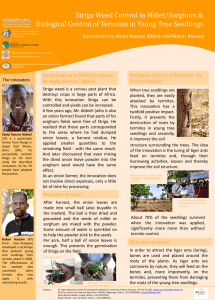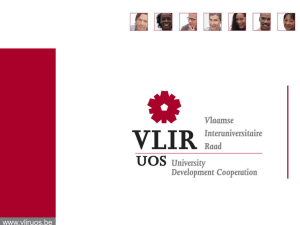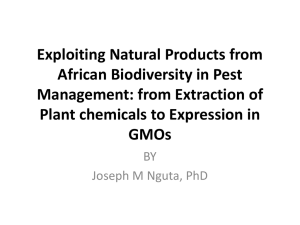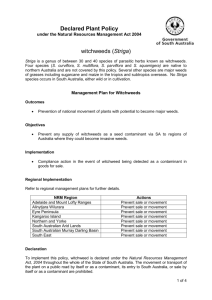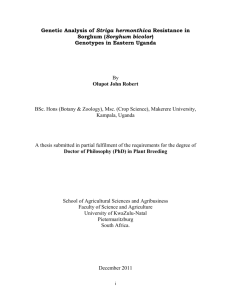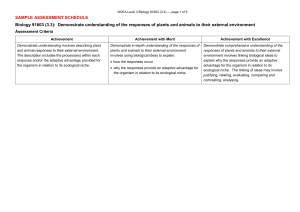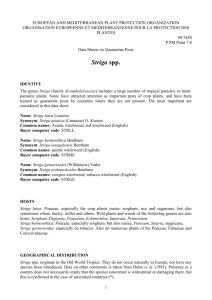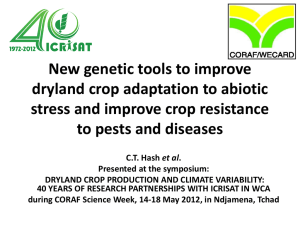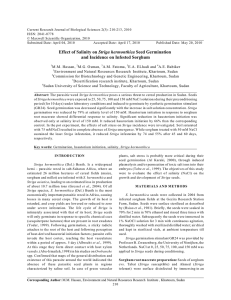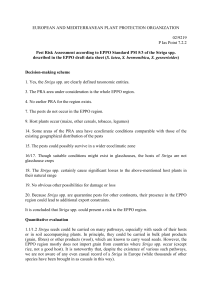Marker assisted breeding for striga resistance in sorghum in Eritrea
advertisement
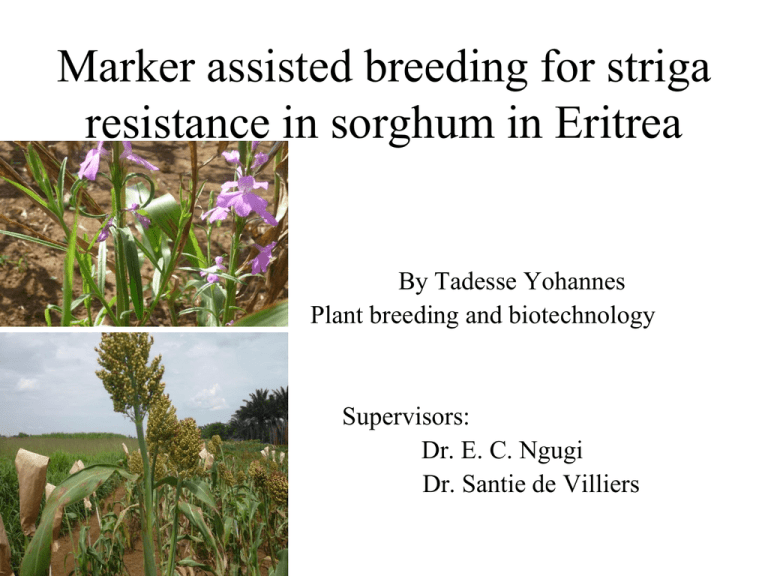
Marker assisted breeding for striga resistance in sorghum in Eritrea By Tadesse Yohannes Plant breeding and biotechnology Supervisors: Dr. E. C. Ngugi Dr. Santie de Villiers Presentation content Introduction Problem statement Justification Objective Methodology Expected output Research project work plan Research project budget. Country profile Eritrea: 4.5 million. 123420 sq. km with 12% cultivable land. Six Agro-ecological zones. Climate ranges from hot to cool - rain fall 200 -800 mm. Agriculture is the main economic activity(80%), contribute 26 % GDP. ERITREA Introduction Sorghum is the fifth most important cereal crop in the world (FAOSTAT 2004). It is grown in at least 86 countries, on an area of 45 million ha, with annual grain production of 65 million t and average productivity of 1.45 t ha-1 (FAOSTAT, 2008). Its origin is in Africa and is critical component of food security in the continent (Dogget 1988). Introduction continued In Africa, annual losses due to striga is estimated as 4.1 million t which is about US$ 7 billion (Sauerborn 1991), adversely affecting over 300 million people (Ejeta and Gressel, 2007). Manipulation of Striga seed numbers is central to Striga control. Development and utilization of Striga resistant variety through a combination of conventional breeding and MAB is efficient. Introduction continued In Eritrea it is mainly grown for ‘enjera’, porridge, and local drink ‘siwa’. the Stover for feed, fuel. Sorghum production in Eritrea is constrained by several factors. Striga hermonthica is a major biotic constraint to sorghum production (Sauerborn,1991). Problem statement Productivity is less than 1 t ha-1. Yield losses due to striga can reach 100% in western zone of Eritrea (Oblina et al., 2002). Some arable lands are abandoned because of striga infestation. The challenge Justification Sorghum is the source of livelihood for many small scale rural households . The use of Marker assisted breeding for striga resistance in sorghum is well proven and tested by IRC such as ICRISAT(Haussmann et al., 2004) . Conventional breeding in the transfer of such traits have been slow , time consuming and complicated with numerous factors: • Results may not be accurate and certain until field tests carried out. General objective To improve sorghum productivity in Eritrea by developing striga resistant sorghum variety. Specific objectives 1.To genotype segregating populations from a cross between a donor and FPSV for striga resistance QTL. 2. Evaluate and identify superior introgressed sorghum lines resistant to striga. Research methodology This project builds on an existing project which generated BC3F1 introgressed lines Breeding scheme FPSV (Hugurtay) X N13 (Donor) F1 X FPSV (Backcrossing) BC1F1 X FPSV FG screening BC2F1 X FPSV FG & BG selection BC3F1 (FG & BG selection, selfing, field evaluation) Methodology continued Laboratory activities Leaf samples will be collected for DNA extraction and analysis. Extraction will be done at ICRISAT Nairobi lab using CTAB extraction method of Mace et al.,2004. Amplification with SSR markers. PCR fragment analysis by capillary electrophoresis Allele size scoring will be done using GeneMapper® Software V4. Lines with the desired QTLs will be selected. Methodology continued Field activities: 1.Seed increase & selfing Introgressed lines with 1- 4 QTLs planted in 1.5m row. 2. Field screening (experiment 1) Lines with1-4 QTLs selected through genotyping to be screened for agronomic performance & striga resistance in artificial infested plots. Site Alupe. Design : augmented design. 3. Field evaluation in replicated trial (expt.2) Design: RCBD with four replications. Each plot with 5 rows of 3m length.(artificially Field screening at Alupe, June 29, 2012 Expected outputs At least one or two striga resistance introgressed lines identified and evaluated. Experience on molecular breeding technique and data analysis gained. A Thesis for the degree of MSc. At least one article published. Work plan ACTIVITIES YEAR 2012 YEAR 2013 Q1 Q2 Q3 Q4 Q1 Q2 Q3 Q4 Proposal writing X X planting, general follow up X X Watering, Weeding, bird scaring X X Genotyping X Thesis write up Submission of first draft thesis X X X X X X X X Harvesting, threshing, cleaning Data collection and analysis X X X X X X X X X X X X X Estimated budget Activities Amount (Kshs) Lab activities 249,000 Field activities & materials 235,000 Agricultural inputs 5,000 Travel expense 71,000 Thesis writing 10,000 contingency 15,000 Total 585,000 ASANTE SANA
